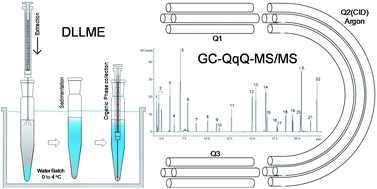Determination of pesticides and related compounds in water by dispersive liquid–liquid microextraction and gas chromatography-triple quadrupole mass spectrometry
Abstract
The declining quality of drinking water supplies due to industrial waste is the result of highly diverse industrial processes. In this context, the establishment of analytical methods focused on monitoring organic compounds related to environmental and health problems is very important. In this study, a quick and effective method based on dispersive liquid–liquid microextraction (DLLME) and gas chromatography coupled with triple quadrupole tandem mass spectrometry (GC-QqQ-MS/MS) was developed and validated for the simultaneous determination of pesticide residues and related compounds in water. The proposed DLLME method uses water sample aliquots of 5 mL, 2 mL of acetone as a dispersive solvent and 50 μL of carbon tetrachloride as an extraction solvent at low temperature. This method was successfully applied for the determination of pesticide residues and related compounds in water at quantification limits between 0.03 and 0.10 μg L−1. The method showed a linear range from 0.05 to 10.0 μg L−1 with r2 > 0.998. Recovery assays presented mean recoveries between 70 and 120% for most of the compounds with good precision, despite different chemical natures of the compounds analyzed.

- This article is part of the themed collection: Analytical Sciences in Brazil

 Please wait while we load your content...
Please wait while we load your content...